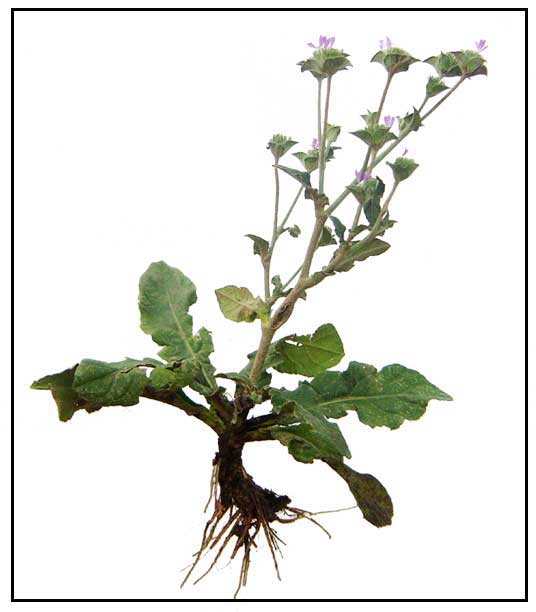|

Botany
Dilang-usa is an erect, branched
and hairy annual herb, 30 to 70 centimeters in height. Leaves are hairy,
oblong to lanceolate, 5 to 12 centimeters long, on short stalks, pointed
at both ends. The hairs on the upper surface of the blade arise
from tubercles. Flowers are borne on long stalks, in axillary
or terminal racemes, of four or five flowers. Calyx is densely hairy, about 1 centimeter long
in the flower. Corolla is pale blue, about 1.3 centimeters in diameter.
 Distribution Distribution
- A weed found in
cultivated areas and waste places at low altitude.
-
Found in Cagayan,
Ilocos Norte, Pampanga, Rizal and Quezon Provinces in Luzon.
- Also occurs in tropical Asia to Mauritius, Malaya, tropical Australia, to eastern tropical Africa.
Constituents
- Yield a low toxic alkaloid supinine.
- Analysis of crude methanolic extract yielded four essential minerals: iron 58.53 mg/kg, manganese 47.5 mg/kg, magnesium 3.43 mg/kg, copper 3.28 mg/kg, and ash value of 23.46%. Analysis also yielded abundant calcium oxalate crystal and nitrate.
(12)
Properties
- Flower considered sudorific and pectoral.
- Leaves are diuretic, emollient, demulcent and diuretic.
- Seeds contain 30% oil.
- Roots considered analgesic and wound healing.
- Studies have suggest antioxidant, wound healing, antimicrobial, anti-inflammatory properties.
Parts used
Leaves, roots, oil.
Uses
Edibility
• In Malawi, leaves cooked as a side dish.
Folkloric
• Leaves are used
as emollient poultice.
• In Ayurveda, used for treatment
of leucoderma and piles.
• Powdered root applied to painful ulcers.
• In Tanzania, oil is used for its
emollient and soothing properties. Used for tonsillitis, coughs, stomachache, and poisoning.
• In Malawi, used for stomach ailments and indigestion. Infusion of leaves and roots used for intestinal worms, coughing, chest complaints, itching and throat pains. Root scraping used for wound dressing.
• In Madagascar, decoction of leaves used as emollient, demulcent and diuretic. Decoction of flowers used as sudorific and diuretic. Externally, powdered root used as analgesic when applied to wounds and skin infections.
• Roots used for bilharzia, swelling of lymph glands, coughing, toothache and abdominal pains.
• In southern India, leaf of the plant is mixed with the rhizome of Glycyrrhiza glabra, stem of Canna indica and stem bark of Punica granatum, then ground into a paste and applied topically to heal wounds. (4)
• In Western Ghats, fresh leaves are roasted with Allium cepa in coconut oil and made into curry. The curry is taken before meals twice daily for four to five days to treat bleeding piles.
- In Ethiopia, roots used for treatment of infertility in women.
(15)
Others
• Pesticide: Aqueous extracts of stems, leaves and fruits reported to be very toxic to cockroaches. (11)
Concerns
Some reports contend it is poisonous
to stock.
Studies
• Wound Healing / Root: Study evaluated in vivo wound healing effect of a herbal ointment formulated with 15% w/w Trichodesma zeylanicum methanolic root extract in excision wounds in albino rats. Results showed wound healing potential. Study suggested further evaluation to assess the potential accumulation of low toxic alkaloid supinine in wound healing. (7)
• Anti-Inflammatory / Alkane: Study evaluated anti-inflammatory activities of isolated phytoconstituents in arthritis models in rats. Results showed alkanoic acid significantly inhibited carrageenan-induced acute arthritis. Alkane also suppressed the development of chronic arthritis induced by CFA. Alkane was the major phytoconstituent reported in the in vivo studies. (8)
• Antioxidant / Free Radical Scavenging Potential / Roots: Study of T. zeylanicum powdered root extract showed good scavenging ability compared to standard ascorbic acid. Reducing power assay showed concentration dependent reducing ability and were higher compared to ascorbic acid. Results suggest a potential source of antioxidants relevant to wound treatment. (9)
• Antimicrobial / Leaves: Study evaluated the antimicrobial activity of T. zeylanicum leaves against selected pathogenic microbes. The crude extract showed activity against S. aureus, P. aeruginosa, S. typhi, and dermatophyte T. mentagrophytes. (12)
Availability
Wildcrafted.
|


![]()

